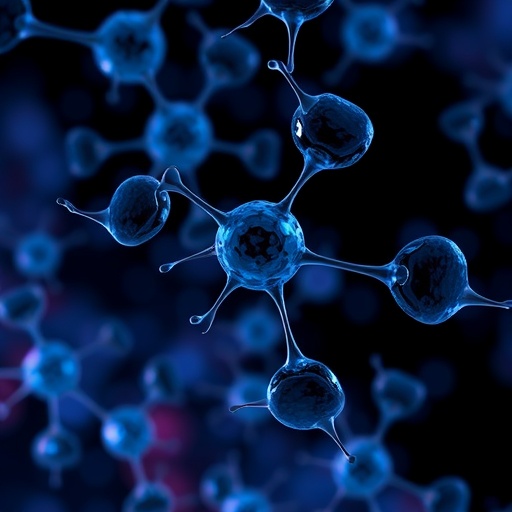In a groundbreaking advancement poised to reshape the landscape of regenerative medicine and hematology, researchers have unveiled a novel stem cell therapy that enhances lymphopoiesis and prevents the onset of age-related hematological diseases in murine models. The study, conducted by Konturek-Ciesla, Zhang, Kharazi, and colleagues, introduces a non-genotoxic approach that bypasses the risks associated with genetic modifications, signaling a transformative step forward in the pursuit of safer, more effective treatments for age-associated blood disorders.
As organisms age, the hematopoietic system—the network responsible for producing blood cells—suffers a marked decline in function. This deterioration manifests notably in reduced lymphopoiesis, the process that generates lymphocytes critical for adaptive immunity. The diminished lymphocyte output compromises immune surveillance and response, predisposing elderly populations to infections, malignancies, and autoimmune conditions. Traditional interventions have struggled to reverse these declines without introducing deleterious genetic mutations or triggering oncogenic pathways.
The therapy presented in this study capitalizes on the utilization of stem cells without resorting to genetic engineering, a critical distinction that addresses longstanding safety concerns in stem cell biology. Instead, the authors have harnessed a sophisticated method of ex vivo expansion and priming of hematopoietic stem cells (HSCs) to amplify their lymphoid differentiation potential. This approach maintains the cells’ genomic integrity, thereby substantially reducing genotoxic risks that have historically deterred clinical translation.
Central to the therapeutic mechanism is the precise modulation of the stem cell niche and intrinsic signaling pathways that govern cell fate decisions. Through meticulous fine-tuning of the ex vivo culture environment—including cytokine cocktails and epigenetic modulators—the researchers achieved an enriched population of HSCs predisposed to lymphoid lineage commitment. This selective enrichment is remarkable in that it sidesteps the genome editing technologies that frequently accompany stem cell manipulation.
In vivo experiments demonstrated that transplantation of these primed stem cells into aged mice rejuvenated their lymphopoietic capacity to levels reminiscent of youthful organisms. Detailed flow cytometric analyses revealed substantial elevations in B and T lymphocyte progenitors within the bone marrow and thymus. Consequently, the recipient animals exhibited enhanced immunocompetence, characterized by improved responses to antigenic challenges and reduced incidence of opportunistic infections.
Importantly, the study also documented a striking decrease in the development of age-associated hematologic pathologies, including myelodysplastic syndromes and certain leukemias. This protective effect is hypothesized to arise from the therapy’s ability to restore a balanced hematopoietic output and mitigate the clonal hematopoiesis of indeterminate potential (CHIP), a precursor state linked to malignancy risks in elderly individuals.
By eschewing genetic alteration, the therapy offers a platform with increased translational potential. The avoidance of double-strand DNA breaks and oncogene activation may circumvent common pitfalls such as insertional mutagenesis, often detected in viral vector-mediated gene therapies. This safety profile could accelerate regulatory approval processes and expand clinical accessibility.
Mechanistically, the research highlights the interplay between extrinsic stem cell niche signals and intrinsic transcriptional networks, specifically implicating modulation of Notch, Wnt, and cytokine signaling pathways in the enhanced lymphopoietic output. Epigenetic profiling further revealed that chromatin remodeling at key lymphoid-specific gene loci promotes stem cell priming without compromising genomic stability.
The implications of this work extend beyond hematology, touching on broader themes of immune aging and regenerative capacity. By demonstrating that physiological aging phenomena can be reversed or delayed through tailored stem cell interventions, the study sets a precedent for tackling other tissue-specific senescence processes.
Moreover, the methodology developed holds promise as a platform for personalized medicine. Patient-derived HSCs could conceivably be harvested, expanded, and conditioned ex vivo prior to autologous transplantation, offering bespoke immune rejuvenation therapies that minimize rejection and graft-versus-host disease risks.
Despite the compelling preclinical data, the transition from mouse models to human applications necessitates cautious optimism. Human HSC biology exhibits notable differences in niche dependence, cell cycle kinetics, and lineage bias. Future investigations will need to adapt and optimize culture conditions, dosing regimens, and delivery strategies appropriate for human physiology.
The study also prompts intriguing questions about the long-term fate and integration of transplanted cells, as well as the possibility of unforeseen microenvironmental perturbations induced by stem cell manipulations. Robust longitudinal studies will be essential to evaluate durability, safety, and potential off-target effects.
From a broader societal perspective, advancements such as this resonate with the urgent demand to alleviate the burden of hematologic diseases in aging populations worldwide. With the global demographic shift toward older age groups, enhancing immune resilience holds critical importance for public health and economic sustainability.
Furthermore, the avoidance of genetic engineering techniques aligns with ethical considerations that often complicate gene therapy applications. A therapy that maintains native genomic structure could find wider acceptance among regulatory bodies, healthcare providers, and patients wary of germline or somatic genome modifications.
Technological innovations underlying this therapy draw upon cutting-edge insights in stem cell biology, niche engineering, and epigenetics, epitomizing the multidisciplinary nature of contemporary biomedical research. The seamless integration of cell culture optimization, molecular signaling manipulation, and in vivo functional validation exemplifies the rigorous translational framework.
In conclusion, this pioneering non-genotoxic stem cell therapy heralds a new era in combating immunosenescence and age-related blood disorders. By effectively boosting lymphopoiesis and conferring protection against malignancies without compromising genomic integrity, it offers a beacon of hope in regenerative medicine. As research propels forward, this approach may soon transcend experimental confines, delivering tangible health benefits to elderly individuals worldwide and redefining therapeutic paradigms.
Subject of Research: Hematopoietic stem cell therapy to enhance lymphopoiesis and prevent age-related blood diseases in mice.
Article Title: A non-genotoxic stem cell therapy boosts lymphopoiesis and averts age-related blood diseases in mice.
Article References:
Konturek-Ciesla, A., Zhang, Q., Kharazi, S. et al. A non-genotoxic stem cell therapy boosts lymphopoiesis and averts age-related blood diseases in mice. Nat Commun 16, 5129 (2025). https://doi.org/10.1038/s41467-025-60464-3
Image Credits: AI Generated




